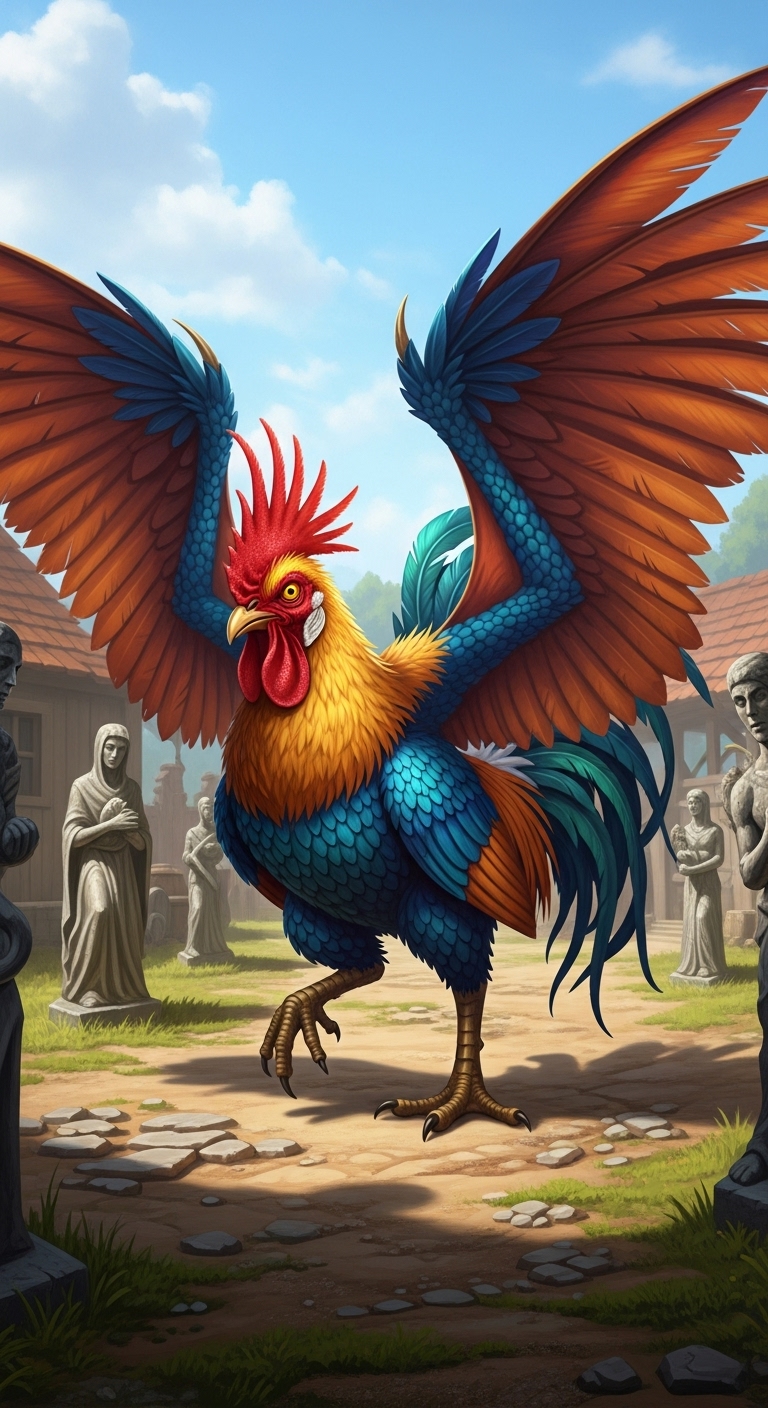Cockatrice

- Size: Small
- Type: Monstrosity
- Alignment: Unaligned
- AC: 11
- Initiative: +1 (11)
- HP: 22 (5d6 + 5)
- Speed: 20 ft, Fly 40 ft .
| ATTR | VAL | MOD | SAVE |
|---|---|---|---|
| STR | 6 | -2 | -2 |
| Dex | 12 | +1 | +1 |
| Con | 12 | +1 | +1 |
| INT | 2 | -4 | -4 |
| Wis | 13 | +1 | +1 |
| CHA | 5 | -3 | -3 |
- Immunities: Petrified
- Senses: Darkvision 60 ft.; Passive Perception 11
- Languages: None
- CR: 1/2 (XP 100; PB +2 )
Actions
Petrifying Bite. Melee Attack Roll: +3 , reach 5 ft . Hit: 3 (1d4 + 1) Piercing damage. If the target is a creature, it is subjected to the following effect. Constitution Saving Throw: DC 11. First Failure: The target has the Restrained condition. The target repeats the save at the end of its next turn if it is still Restrained, ending the effect on itself on a success. Second Failure: The target has the Petrified condition, instead of the Restrained condition, for 24 hours.
Lore & Background
Cockatrices are small but dangerous avian monstrosities with the head and wings of a rooster, the tail of a serpent, and the ability to turn living creatures to stone with their bite. These creatures are often found in desolate areas where their petrification abilities have created eerie sculpture gardens of their victims. Despite their small size, cockatrices are feared by travelers and locals alike due to their deadly supernatural abilities.
The origin of cockatrices is steeped in folklore and magical theory. Some scholars believe they are the result of serpents hatching eggs laid by roosters during certain astrological alignments, while others theorize they are created through magical experimentation or cursed transformations. Regardless of their origin, cockatrices have become symbols of unexpected danger and the perils of underestimating seemingly harmless creatures.
These creatures are territorial and aggressive, establishing small domains around their nests where they hunt for food and defend against intruders. They are not particularly intelligent, operating on instinct and basic survival needs, but their natural cunning and deadly abilities make them formidable opponents despite their diminutive stature. Cockatrices are known to be particularly aggressive during mating season and when protecting their young.
Combat Tactics
Cockatrices rely heavily on their petrifying bite as their primary weapon, using their flight ability to stay mobile and strike quickly at vulnerable targets. They prefer hit-and-run tactics, swooping in to bite an opponent before retreating to a safe distance to observe the effects. Their small size and aerial mobility make them difficult targets for melee-focused opponents.
When facing multiple enemies, cockatrices often target the weakest-looking opponent first, hoping to quickly remove them from the fight through petrification. They are cowardly creatures that will flee if seriously injured or outnumbered by opponents who prove resistant to their bite. Their flight speed allows them to escape most ground-based pursuers.
Against armored opponents, cockatrices look for exposed flesh or gaps in protection where their bite can be most effective. They are patient hunters who will circle their prey, looking for the perfect opportunity to strike. Their natural agility and small size make them adept at avoiding attacks while positioning themselves for optimal striking opportunities.
Encounter Ideas
The Stone Garden: Travelers discover an area filled with lifelike stone statues of animals and people - former victims of a cockatrice that has made its nest in the vicinity.
The Rooster's Revenge: A cockatrice has taken up residence near a farming community, turning livestock and pets to stone, threatening the local economy and way of life.
The Alchemist's Prize: An alchemist or wizard seeks live cockatrice specimens for magical experiments, requiring the heroes to capture rather than kill these dangerous creatures.
The Cursed Flock: Multiple cockatrices have nested in ancient ruins or a abandoned settlement, creating a significant hazard for anyone trying to explore or reclaim the area.
Environmental Effects
Petrified Remains: Areas where cockatrices hunt are littered with stone statues of their victims, creating macabre landmarks and warnings for other creatures.
Territorial Markings: Cockatrices mark their territory with distinctive claw marks on trees and rocks, along with shed feathers and serpentine scales.
Disturbed Wildlife: The presence of cockatrices causes local wildlife to avoid the area, creating an unnatural silence that serves as a warning to observant travelers.
Nesting Sites: Cockatrice nests are typically built in elevated locations like cliff faces or tall trees, surrounded by the petrified remains of their prey.
Treasure
Petrified Valuables: Items belonging to the cockatrice's victims remain with their stone forms, including weapons, armor, jewelry, and coins that can be recovered if the petrification is reversed.
Cockatrice Parts: The creature's feathers, scales, and organs are valuable alchemical components used in creating potions of stone-to-flesh and other protective magic.
Nest Treasures: Cockatrices sometimes collect shiny objects for their nests, accumulating small hoards of coins, gems, and trinkets taken from their victims.
Petrification Antidotes: Areas where cockatrices are known to hunt often contain natural remedies or magical items that can reverse their petrification effects.
Plot Hooks
The Cursed Bloodline: A family has been cursed so that their livestock periodically transform into cockatrices, threatening both their livelihood and the safety of their community.
The Petrified Witness: The only witness to a crucial crime has been turned to stone by a cockatrice, and the heroes must find a way to restore them before important evidence is lost.
The Magical Experiment: A wizard's attempt to breed cockatrices with other creatures has created new and more dangerous hybrid monsters that threaten the surrounding region.
The Living Statue: What appears to be an ornamental statue in a garden or public square is actually a person petrified by a cockatrice, and they begin to show signs of returning to life at inconvenient moments.